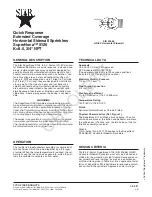
PAGE 6
User Manual PS 279 / August 2016 © ASL Intercom BV
13
SIDE TONE trimmers
To adjust
the level of one’s own voice as heard in
one’s headset. Adjustment procedure:
set the trimmer in start position: fully
clockwise
switch off the microphone of all connected
(speaker) stations
switch on the microphone of the required
channel
turn up the volume of the required channel
speak into the headset microphone
adjust the listen level by turning the side
tone trimmer
The operating area is between fully clockwise and
minimum level. Adjusting the side tone does not
affect the level of your voice as it is heard by
other user stations.
14
TALK buttons A & B
These buttons allow talking to each channel
separately or both channels simultaneously.
If a Talk button is activated, its green LED is lit.
Latched switching
:
If a TALK button is pushed shortly it is
electronically latched and the microphone signal
is sent to the referring channel. If the button is
pushed again, the connection between
microphone and the channel is cut off.
Momentary switching:
If a TALK button pushed and held, the
microphone signal is sent to the referring channel
until the button is released.
15
CALL buttons A & B
To activate the CALL system. A momentary push
sends a visual Call signal to all stations
connected to the referring intercom channel and
the Call LEDs start flashing. If holding the buttons
pushed for 2 seconds, the buzzers are activated.
After the CALL button is released the LEDs
continue to flash for a further 2 seconds.
16
MIC GAIN trimmer
To adjust the gain of the microphone signal
17
HEADSET connector (XLR-4)
To connect the headset to the PS 279.
The headset can must have a minimum
impedance of 200 ohms. In case of two cans in
parallel, each can must have a minimum
impedance of 400 ohms. The headset mic may
be of the dynamic or electret type.
Pin assignments:
Pin1: shield mic. (GND)
Pin 2: mic. +
Pin 3:
Pin 4: phones
–
In case of 2 headset cans the wiring is such that
both cans receive the same signal. The two
headphone amplifiers run in a bridged mode.
As an option, an XLR-6 type connector can be
fitted to allow a binaural headset configuration
where a different signal will appear on each can.
(See also section 7). In this mode the internal
headphone amplifiers are not bridged.
6.0
REAR PANEL CONTROLS AND CONNECTORS
18
DC INPUT connectors
These connectors accept 24
– 30 V DC as a
(backup) power source should mains power not
be available or fail.
19
SYSTEM LINK IN connectors (XLR-3)
Input for the cable of an external party-line
Intercom system. If a channel of the PS 279 is to
be connected to another intercom system this
connector accepts the communication signals
from the other system. See also #4 and #5.




























